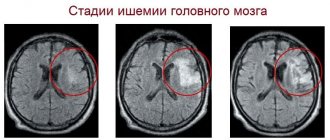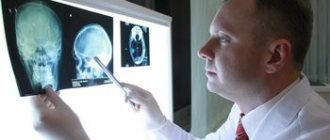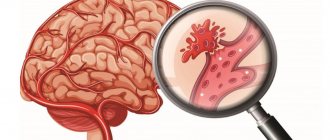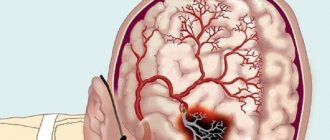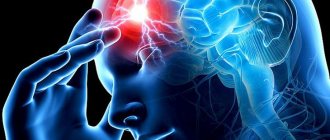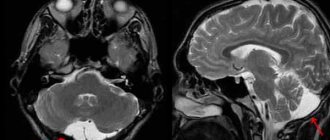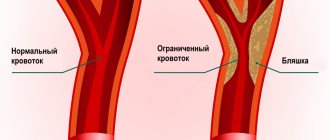According to statistics, vascular diseases of the brain account for about 42% of all abnormalities of the nervous system. In the field of neurology, cerebrovascular accidents are recognized as one of the most common ailments. Affecting a significant number of elderly people and patients of older working age, these diseases pose a serious threat not only to normal life activities, but also to the patient’s life itself. Vascular pathologies require great attention from specialists and timely and effective treatment.
When it comes to vascular pathologies, they most often mean discirculatory encephalopathy. This is a slowly progressive vascular lesion of the brain. The course of the pathology is divided into three stages in accordance with the severity of the clinical picture. At the initial stage, the symptoms are not clearly expressed, so problems arise with making a diagnosis. Some symptoms indicate mental disorders, so errors in the anamnesis often occur. As a rule, an accurate diagnosis is made after a prolonged presence of the main symptoms (dizziness, impaired coordination and cognitive functions).
Classification of vascular diseases of the brain
There are two main groups of vascular pathologies: acute and chronic cerebrovascular accidents. The first group is divided into three subgroups: transient cerebrovascular accidents, cerebral strokes, mixed strokes. Transient disorders of cerebral circulation include transient ischemic attacks and hypertensive crises. Brain strokes are ischemic and hemorrhagic. Hemorrhagic strokes are divided into subarachnoid hemorrhage, parenchymal-subarachnoid hemorrhage, and ventricular-parenchymal-subarachnoid hemorrhage. Ischemic strokes, in turn, are divided into lacunar, atherothrombotic, cardioembolic and hemodynamic stroke.
The second group includes: chronic subdural hematoma, initial manifestations of cerebrovascular insufficiency, subcortical vascular dementia, discirculatory encephalopathy. The initial manifestations of cerebrovascular insufficiency are divided into two stages. The first stage is characterized by the absence of neurological manifestations. At the second stage, neurological manifestations are clearly expressed. Discirculatory encephalopathy is the most common among chronic cerebrovascular accidents. It is divided into three main stages:
- The first stage is moderately severe, characterized by diffuse symptoms. The patient may complain of short-term headaches, periodically suffer from sleep disorders and increased irritability.
- The second stage is more pronounced; clinical manifestations form in it. The person often experiences surges in blood pressure, loss of space, and cognitive impairment. As a rule, at this stage the disease is most often diagnosed.
- The third stage is pronounced, during which irreversible changes occur in the body. Serious disturbances in memory and cerebral circulation in general appear. In rare clinical situations, complications in the form of strokes are observed (in the absence of timely consultation with a doctor).
Types of diseases
In clinical practice, and then in theory, a huge number of pathologies leading to malfunctions of the central nervous system were identified. The most common of them can be highlighted in a list:
- Vascular aneurysm. It is a pathogenic expansion of the vascular wall, which loses elasticity and risks rupture, leading to internal hemorrhage. It is very difficult to save a person in such cases.
- Atherosclerosis. Appears when there is micro-trauma to the vascular wall, at the site of damage a cholesterol plaque forms, and then a blood clot. The lumen of the blood channel becomes clogged, blocking the path to oxygen and microelement nutrition of neurons, which is why they begin to die.
- Stroke. A vascular anomaly that often develops in old age. Leads to the death of areas of the brain (BM) in which blood circulation is disrupted. In the hemorrhagic form of the attack, the canals rupture, leading to internal hemorrhage, and it is very difficult to save the patient. Ischemic stroke is less dangerous but more common.
- Alcoholic encephalopathy. Systematic drinking of alcohol leads to gradual, non-renewable death of neurons, as a result of which a person loses cognitive abilities, intelligence, and psycho-emotional stability.
- Intracranial hypertension. It manifests itself as high intracranial pressure caused by the growth of a tumor, cyst or aneurysm inside the head.
- Malformation. Congenital defect in the structure of the vascular network.
- Alzheimer's disease. Excessive production of a pathogenic protein enzyme that accumulates in brain tissue and destroys nerve cells. Next, the functioning of internal systems and organs fails, after which death occurs.
- Various tumors. Neoplasms from aggressively growing cells of the body.
- Epilepsy. Impaired bioelectrical function of the brain, as a result of which periodic convulsions develop.
- Hydrocephalus. It is characterized by impaired exchange of cerebrospinal fluid, which begins to accumulate in the intracranial cavities. There is constant pressure on the brain, which causes its functioning to suffer.
The signs of all these diseases are largely similar, if you do not take into account specific manifestations, which almost do not appear in the early stages.
Causes of pathology
Vascular diseases of the brain can occur for a number of reasons. As a rule, several reasons lead to the appearance of pathology. The most common ones include:
● genetic predisposition;
● narrowing and hardening of intracerebral arteries (with hypertension);
● multiple focal and/or diffuse brain lesions;
● long-term somatic diseases of the expectant mother (and during pregnancy);
● atherosclerosis of cerebral vessels;
● rheumatic lesions;
● disturbances in the functioning of the respiratory system (for example, pulmonary edema);
● abuse of alcohol and tobacco products during pregnancy;
● disturbances in metabolic processes;
● increased blood viscosity;
● fractures of the skull bones;
● heart rhythm disturbance (with atrial fibrillation, blood hemodynamics are disrupted);
● serious abnormalities in the nervous system (increased anxiety, chronic stress);
● serious abnormalities of the endocrine system (diabetes mellitus, obesity);
● development of intrauterine infections;
● difficult long labor (with injuries);
● hypertension;
● hypercholesterolemia;
● various anomalies of the cardiovascular system (for example, hypoplasia of cerebral vessels, mitral valve prolapse).
A brief excursion into the anatomy of the central nervous system
The human brain is a complex organ responsible for the functioning of the entire organism. There is a clear hierarchy in the structure of the brain, which allows the entire body to work effectively. The central nervous system can be divided into several main parts:
- The cerebral cortex is responsible for higher nervous activity, i.e. thought processes, speech, memory, writing, hearing and many other functions.
- Subcortical structures that form the midbrain. The midbrain is responsible for the primary reflex units and the formation of unconditioned reflexes.
- The bridge is a connecting link between all parts of the central nervous system and the cerebral cortex.
- Cerebellum. It is located in the lower occipital part of the head and is responsible for human coordination in space.
- The medulla oblongata connects the brain with the spinal cord and is its continuation. The medulla oblongata contains vital centers: vasomotor and respiratory.
Risk group
The risk group includes people with infectious pathologies during the neonatal period. The likelihood of developing vascular diseases of the brain increases significantly with hemolytic anemia, surgery and head injuries. The mother’s poor lifestyle (abuse of alcohol and tobacco products) can also negatively affect the condition of the child’s brain. A family history of cardiovascular pathologies (for example, myocardial infarction or arterial hypertension in close relatives) doubles the risk of developing cerebrovascular diseases.
Viral and prion infections
There are a huge variety of viruses that cause acute encephalitis (mosquito, tick-borne, epidemic), in general they differ in vectors and geography of distribution.
Focal symptoms occur against the background of “general infectious manifestations”, these are:
- paresis
- respiratory muscle paralysis
- paralysis of limbs,
- paralysis of facial muscles, etc.
Rabies and slow infections can pose a huge danger, and therefore special attention is paid to them.
Rabies. Almost all mammals can suffer from rabies. The source of infection is usually dogs, wolves, foxes, and it is through the bite of infected animals that this dangerous infection is transmitted to humans. Symptoms:
- hydro and aerophobia
- convulsions
- attacks of aggressive behavior.
Emergency vaccination after a bite is the only way to recover, so waiting for the first symptoms of the disease to develop is prohibited, since this can only indicate that the person can no longer be saved.
Slow infections are viral neuroinfections that have the ability to remain asymptomatically in the human nervous tissue for a long time, with the subsequent development of the disease.
Scientists have identified four main characteristics that distinguish slow infections:
- unusually long (months or years) incubation period;
- slowly progressive nature of the course;
- unusualness of damage to organs and tissues;
- the inevitability of death.
The causative agents of the virus are rubella and measles. For reasons that are not entirely clear, these viruses can remain in brain cells after an illness and cause disease after 4 or more years. Both viruses cause panencephalitis with similar symptoms:
Personality changes with the development of dementia
Gradual paralysis of all striated muscles.
Unfortunately, even with treatment, the consequences of these neuroinfections are always the same - death.
Prions Prions are “proteinaceous infectious (particles).” Prions are defined as “a small proteinaceous infectious particle that is resistant to inactivating influences that modify nucleic acids.” In other words, prions are ordinary proteins of the body that for some reason (which is still unknown) they begin to behave “wrongly”.
There are four types of prion neuroinfections, and only one of them has a clear transmission mechanism. In some tribes of Papua New Guinea, cases of kuru-kuru were often reported due to the previously widespread ritual cannibalism of eating the brains of relatives. Prions cause spongiform encephalopathy, which means the brain turns into a sponge.
Diagnosis of pathology
If the symptoms described above appear, it is recommended to immediately consult a cardiologist or neurologist. During the initial examination, the specialist collects an anamnesis of the patient’s life, asks in detail about his complaints (how long ago and under what circumstances they appeared), about diseases of the cardiovascular system of his closest relatives. Based on these data, further examination is prescribed.
To diagnose vascular diseases of the brain, they resort to laboratory and instrumental diagnostics. First of all, the patient is prescribed a general and biochemical blood test to determine the level of cholesterol, glucose, triglycerides, lipoproteins and prothrombin index (PTI). These substances affect the functioning of the heart and blood vessels. Biochemical indicators are very important in making a diagnosis. An increased level of leukocytes indicates the presence of an inflammatory process in the body. Among the instrumental diagnostic methods, the following are in particular demand:
● electrocardiography (ECG). This is a simple technique that does not require additional preparation. The essence of an ECG is to record the electrical potentials of the heart, due to which it is possible to detect changes in rhythm, electrolyte deficiency and other initial signs of cardiovascular pathologies;
● Doppler ultrasound of the vessels of the neck and brain (USDG). This is a modern, highly informative diagnostic method. It is used to determine damage to the arteries and indicates insufficient blood supply to the brain. With its help, it is possible to assess blood flow in the vessels of the neck and head;
● duplex scanning of blood vessels. Thanks to color contrast of flows during duplex scanning, it is possible to more clearly distinguish between moving and stationary objects (blood and vessels, respectively);
● ultrasound examination of the heart (ultrasound). This technique makes it possible to visually view the contractions of the heart muscle, assess the condition of its valves, and diagnose heart failure;
● echocardiography (EchoCG). Sometimes specialists prescribe echocardiography in addition to an ECG. This is a highly accurate examination method, with its help it is possible to assess the condition and determine the size of the valves;
vascular magnetic resonance imaging (MRI). This is a completely safe technique for the body (there is no radiation), it shows the lumen and patency of large vessels, and makes it possible to detect abnormalities in vascular development.
Prevention of vascular diseases of the brain
Vascular diseases of the brain are easier to prevent than to cure. To do this, experts recommend leading a healthy lifestyle: engaging in moderate sports, drinking about 1-1.5 liters of water per day (to avoid dehydration), eating properly and following a diet. The diet involves limiting table salt and foods containing large amounts of animal fats (for example, sour cream and fatty meats). Fresh vegetables and fruits should prevail in the daily diet. A split diet is recommended (4-5 meals per day).
The intake of alcoholic beverages should be minimized (or completely abandoned). The emotional component is the key to good health, so you should not be exposed to stressful situations. Sleep should be complete (at least 7 hours of sleep per day are required). Moderate physical activity should be regular; it significantly improves the condition of the body. These include: swimming, yoga, Pilates, cycling.
Exercising and proper nutrition help prevent the appearance of excess weight, while they train the cardiovascular system. At least once a year it is required to undergo a study of the state of cerebral circulation (especially for those who are at risk). This will allow timely detection of pathology.
In order to prevent the progression of multi-infarction conditions, patients are prescribed combination therapy (antiplatelet and anticoagulant). The most suitable anticoagulants are selected depending on blood clotting parameters. If any signs of bleeding appear, it is important to contact a specialist promptly.
Vascular diseases of the brain are often accompanied by dizziness. To prevent them, doctors prescribe medications that affect the autonomic nervous system. To prevent cognitive impairment (memory deterioration, increased inattention), drugs that improve metabolism are prescribed. In the presence of movement disorders, therapeutic exercises, physiotherapy, massage and other methods of rehabilitation therapy are useful.
Brain Facts
- The average brain weight is 1300-1400 grams. That is, having a mass of no more than 2% of the entire body, it consumes a quarter of all energy.
- The brain is 60% fat.
- Has no pain receptors. Therefore, when neurosurgeons perform operations, they inject painkillers only into the scalp
- From large doses of alcohol, the brain loses the ability to create memories. Therefore, when a person has a large dose of alcohol, he does not remember the events that occur.
- The brain often doesn’t care whether you actually do something or imagine it in pictures. If you imagine a dangerous and extreme situation in your mind, your heart rate will immediately increase. This feature of our psyche has long been known to athletes. Many of them do visualization before competitions: they imagine all sorts of situations that could happen to them during tournaments. Research has proven that this method improves the performance of athletes because it prepares their muscles and body.
- There is a phenomenon known as phantom pain. For example, when a person's leg is amputated, he still experiences pain in it. This happens because there are nerve endings in the brain that are responsible for sensing pain in that leg.
